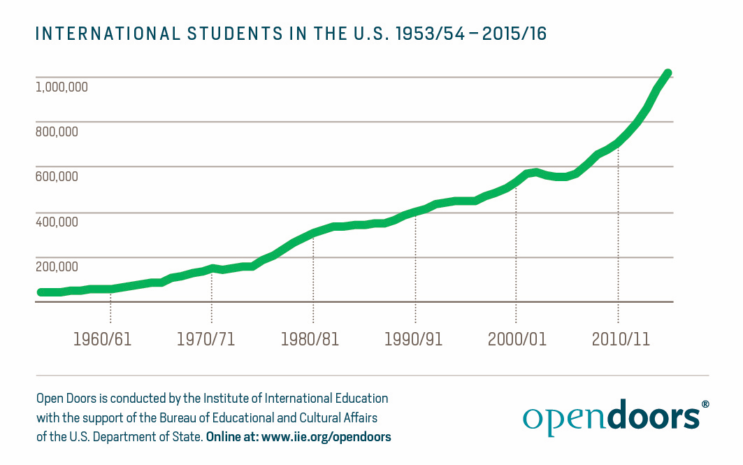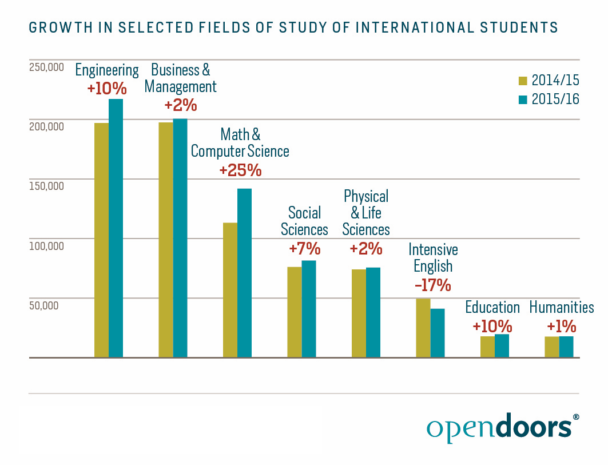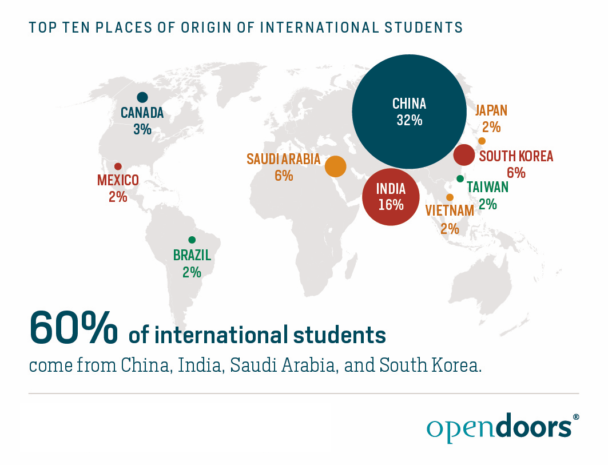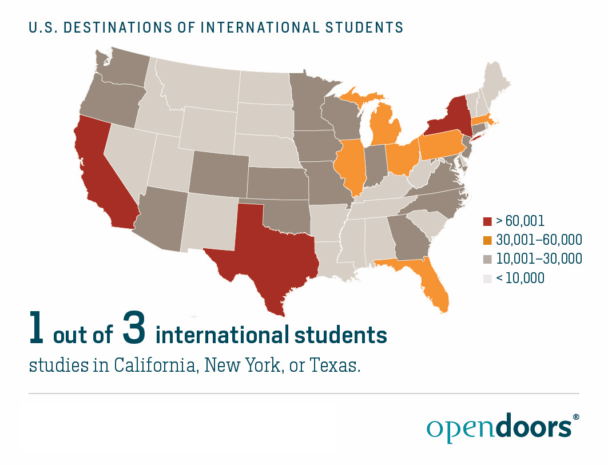International Students Top One Million, Contributing $32.8 Billion to U.S. Economy
Date: December 5, 2016
For the first time, the number of international students enrolled in U.S. colleges and universities exceeded one million, making up over 5 percent of the 20 million students pursuing higher education in the United States during the 2015-2016 academic year.
These 1,043,839 international students represent a 7.1-percent increase from the previous academic year, according to the annual Open Doors Report, released last month by the Institute of International Education (IIE) and the U.S. State Department’s Bureau of Educational and Cultural Affairs.

Some worry that an influx of international students may crowd out U.S. students at colleges and universities. But increasing evidence shows that more international students actually expands native-born enrollment because foreign students often pay higher tuition, allowing universities to enroll more students overall. For example, a recent study examined enrollment data from 1995 to 2005 and found that each addition of an international graduate student led to one more enrollment of a U.S. graduate student.
And because international students pay more than double for tuition than do their U.S. in-state peers, their enrollment brings in revenues that are particularly beneficial to public colleges and universities. After years of cuts in financial support, funding for public colleges is still $10 billion below its pre-recession level, resulting in schools raising tuition and cutting educational services.
NAFSA, the Association of International Educators, estimated the economic contributions of international students to be more than $32.8 billion, a 7.6-percent increase from the previous year. As a result of their spending, international students supported 400,812 jobs across the United States. About 54 percent of these jobs were directly created by international students’ payment of tuition and fees; the rest were supported by their spending on things like accommodation, dining, retail, and transportation. In some states, the number of jobs supported was substantial: For example, international students supported 59,521 jobs in California, 46,854 in New York, and 31,550 in Massachusetts.
Rising student debt has become an increasing concern for American students and policymakers alike. According to the Institute for College Access and Success, nearly 70 percent of students who graduated from public and nonprofit colleges in 2014 carried student loan debt—nearly $30,000 of it, on average. Yet international students are more likely to fund their education themselves: Two-thirds of international students used personal and family sources as primary funding, compared with 17 percent who primarily used financial assistance from U.S. schools, 7 percent from foreign governments and universities, and 7 percent from their employers, according to the IIE report.
Another economic concern is whether there will be sufficient numbers of students graduating in the fields of science, technology, engineering, and math—or “STEM” fields—to fill jobs in these rapidly growing industries. According to NAE’s recent research, between 2014 and 2024, STEM fields are projected to play a key role in U.S. economic growth, growing 37 percent faster than the U.S. economy as a whole. Fortunately, data show that international students are helping to meet this demand by continuing to concentrate in STEM fields. More than one-third of them studied engineering, math, computer science, or physical and life sciences last year. Math and computer science saw the fastest growth in the number of international students last year, with a 25-percent hike from the previous year. The field of engineering also experienced an increase of 10 percent.

China remained the top source of international students, sending 328,547 of its students to enroll in the United States last year, almost twice the number of students from India, the second-highest sender. About 43 percent of Chinese students chose STEM majors, followed by 24 percent who studied business and management.
Interestingly, though, the pace of growth in the number of Indian students has outpaced that of Chinese students for two years in a row. After a double-digit growth in the number of Indian students between 2013 and 2014, the number increased again by nearly 25 percent to 165,918 last year. The data also show that three out of every four Indian students majored in a STEM field.

Each of the top ten states hosting international students, including California, New York, Texas, Massachusetts, and Illinois, experienced growth in international student enrollment last year. California saw an increase of 10.5 percent to about 150,000 international students last year, followed by Florida with a rise of 10.4 percent.

Though the United States continues to be a top destination for students from around the world, it is starting to lose ground in the global competition for talent. Between 2001 and 2016, the number of international students worldwide has almost doubled from 2.1 million to 4.1 million, but the U.S. share of those students has decreased from 28 percent to 25 percent, according to data from IIE’s Project Atlas.
Remaining a top attraction for foreign students will not only boost U.S. economic growth but will also ensure that the United States remains on the cutting edge of innovation. To think about how the United States can strengthen its position as the magnet for international students, read more from NAE’s in-depth case study on the economic impact of attracting and retaining international students in Ohio. Meanwhile, explore NAE’s policy recommendations based on a comparative study of immigration reforms other countries employ to boost their economies and lure the talent needed for continued economic growth.
